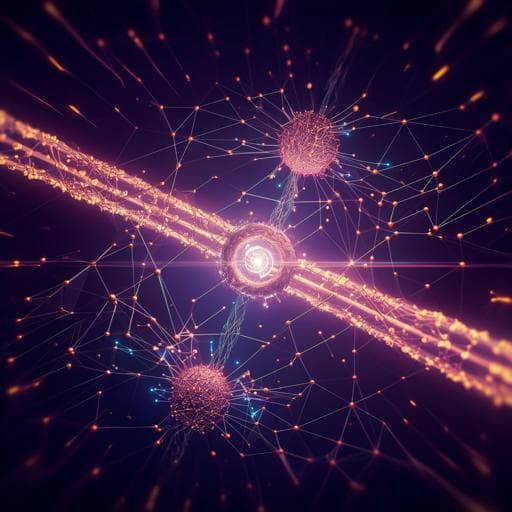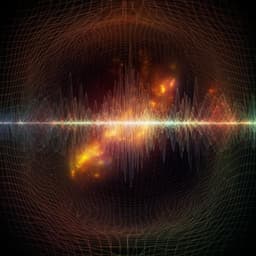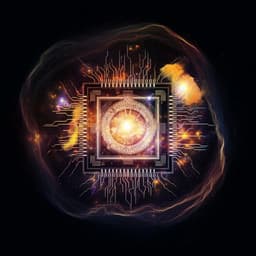
Physics
Measurement-induced entanglement and teleportation on a noisy quantum processor
J. C. Hoke, M. Ippoliti, et al.
This groundbreaking research examines measurement-induced quantum information phases using up to 70 superconducting qubits on noisy intermediate-scale quantum processors. Led by an extensive team of authors, the study reveals varying noise sensitivities in phases and provides insights into achieving measurement-induced physics with today's technology.
~3 min • Beginner • English
Introduction
The study investigates how measurements embedded in many-body quantum dynamics give rise to measurement-induced phases—entangling (volume-law) versus disentangling (area-law)—and how to realize and diagnose these phases on noisy superconducting quantum processors without mid-circuit measurements. The context is that projective measurement, unlike unitary evolution, collapses the wavefunction and enables protocols such as teleportation, error correction, and measurement-based computation, building structured quantum information across space-time. Monitored circuits combining random unitaries with measurements are predicted to exhibit phase transitions in entanglement structure as measurement rate varies. Experimentally, probing these effects is challenging due to the stochastic nature of measurement (requiring post-selection over exponentially many trajectories) and hardware constraints (slow, error-prone mid-circuit readout). The purpose of this work is to overcome these obstacles using space-time duality to map 1D monitored dynamics to 2D shallow unitary circuits with final measurements, and to devise a scalable hybrid quantum-classical decoding protocol that extracts an order parameter from correlations between a probe qubit’s readout and classically decoded information. The importance lies in demonstrating measurement-induced entanglement and teleportation on up to 70 qubits, identifying noise sensitivity as a phase diagnostic, and clarifying NISQ-era limitations.
Literature Review
The paper builds on theoretical predictions of measurement-induced entanglement transitions in monitored random circuits and related frameworks, including area-law versus volume-law entanglement scaling and critical behavior (e.g., works by Skinner, Nahum, Fisher; Chan, Vasseur, Potter; Jian et al.; Gullans and Huse). It leverages space-time duality mappings that relate monitored 1D circuits to shallow 2D unitary circuits, enabling postselection-free diagnostics in some cases (Ippoliti, Khemani; Lu and Grover). Prior experimental studies have realized aspects of measurement-induced phases in trapped ions and superconducting platforms, often restricted to Clifford circuits or small sizes due to sampling costs and mid-circuit readout limitations. The effects of noise on monitored dynamics have been explored theoretically, with expectations that finite noise destabilizes sharp non-equilibrium phases; works also propose scalable probes using classical simulation and cross-entropy-like benchmarks and decoders (e.g., Gullans & Huse; Li et al.; neural-network decoders). This study integrates and extends these directions by avoiding mid-circuit measurements via duality, using randomized measurements for entropies, and introducing a scalable local-probe decoding method applicable to generic circuits.
Methodology
- Space-time duality: Map 1D monitored circuits into 2D shallow random unitary circuits with measurements only at the end, circumventing mid-circuit measurement. The effective measurement rate p is controlled by the shallow circuit depth T and number of measured qubits M; heuristically p ≈ M/[(M+L)T], where L is the length of the unmeasured edge chain.
- 2D shallow random circuits: Implement on superconducting qubit grids. Circuits composed of iSWAP-like two-qubit gates and random single-qubit rotations chosen from {x, y, w, v}, with w = (X+Y)/√2 and v = (X−Y)/√2, arranged in cycle sequences over the 2D layout.
- Entropy and correlation diagnostics in a 19-qubit subset: For depths T = 1…8, measure M = 12 qubits at the end and leave L = 7 edge qubits. Use randomized measurements to estimate the second Rényi entropy S2 of contiguous subsystems A of the L = 7 edge chain. Compute second Rényi mutual information I2 between disjoint two-qubit subsystems A and B as a function of separation x and depth T.
- Post-selection and control: Post-select on the most probable bitstring for the M measured qubits to access individual quantum trajectories where needed; also analyze data without post-selection to assess the role of measurement records.
- Scalable decoding protocol (local probe): For larger processors (N up to 70 qubits), choose a probe qubit near the middle of one side. For each experimental run, measure all qubits at the end, obtaining probe readout z_p ∈ {±1} and measurement record m on surrounding qubits. Classically compute the Bloch vector a of the probe conditional on m (tractable for depth τ = 5 on the target sizes). Define ζ = sign(a_m^z) (±1 depending on the Bloch vector pointing above/below the equator). Define the cross-correlator ζ̄ = 2⟨z_p ζ⟩ over shots and random circuits, which estimates the Bloch vector length and maps to a proxy entropy S_proxy = −log2[(1+ζ̄)/2].
- Decoding geometry: Decode using measurement records within a radius r (in lattice steps) from the probe side, while tracing out others. r_max corresponds to using all measured qubits except the probe.
- Tuning the transition continuously: Fix circuit depth τ = 5 and introduce a gate density ρ by applying each iSWAP-like gate with probability ρ (skipping otherwise). This sets an effective depth T_eff = ρ τ that can be tuned continuously across the transition.
- Noise mitigation and normalization: Use ζ_max (decoded using r = r_max) to normalize ζ̄(r): define ζ_norm(r) = ζ̄(r)/ζ_max. Define S_proxy(r) = −log2[(1+ζ_norm(r)^2)/2] to estimate noise-mitigated behavior. Compare behaviors across ρ and system sizes N = 12, 24, 40, 58, 70.
- Sampling: For each N and ρ, collect data from 2,000 random circuit instances with 1,000 shots each. Fit ζ̄ at ρ = 1 to estimate per-sequence error rates from the decay of the decoded signal with N.
- Analysis without post-selection (control): Show that omitting post-selection yields vanishing long-range mutual information, highlighting the necessity of conditioning on measurement outcomes to observe the phases.
Key Findings
- Entanglement phases and transition in 2D shallow circuits mapped from 1D monitored dynamics: For L = 7 edge chains, Rényi-2 entropy S2 of contiguous subsystems shows subextensive scaling for T < 4 (area-law, disentangling) and approximately linear (volume-law, entangling) scaling for T ≥ 4. Rényi-2 mutual information I2 between disjoint subsystems decays rapidly with distance in the area-law phase (e.g., T = 3) and remains finite at long distances in the volume-law phase (e.g., T = 6). For maximally separated 2-qubit subsystems, I2 remains finite for T ≥ 4 and vanishes for T ≤ 3. Without post-selection, long-ranged correlations vanish, confirming the role of measurement conditioning.
- Scalable decoding and teleportation signature: The local-probe decoding protocol defines ζ̄ = 2⟨z_p ζ⟩ and S_proxy = −log2[(1+ζ̄)/2], interpreting ζ as a classical correction analogous to teleportation’s feed-forward. Persistence of entanglement with increasing decoding radius r beyond the probe’s unitary light cone indicates measurement-induced teleportation.
- Noise as a diagnostic: ζ_max decays with system size N at high gate densities due to noise, but remains approximately constant at low ρ. The disentangling phase shows sensitivity to noise only within a finite correlation length, whereas the entangling phase is sensitive to noise anywhere in the system.
- Critical parameters: ζ_max versus gate density ρ suggests a transition around ρ ≈ 0.6–0.8. Noise-mitigated S_proxy(r) decays rapidly to 0 and is N-independent for ρ = 0.3 (disentangling), but exhibits a large, finite plateau up to r_max−1 for ρ = 1 (entangling). At fixed N = 40, S_proxy(r) shows a crossover for intermediate ρ. Finite-size crossings of S_proxy(r_max−1) versus ρ for N = 12, 24, 40, 58 occur near ρ ≈ 0.9 experimentally, drifting upward with N; noiseless classical simulations estimate an ideal finite-size crossing near ρ ≈ 0.72.
- Quantified noise level: At ρ = 1 and τ = 5, fits give ζ̄ ≈ 0.97, indicating an error rate of roughly 3% per qubit for the full sequence, consistent with expectations from gate and measurement error rates.
- Practical NISQ limits: Extrapolation at current error rates suggests that for τ = 5, arrays larger than about 150 qubits (<1% N-qubit fidelity) would be too entangled with the environment to detect ideal entanglement structures, implying an upper experimental limit of roughly 12×12 qubits for these protocols without improvements in coherence.
Discussion
The results demonstrate that measurement-induced entanglement phases can be realized and probed on noisy superconducting processors at unprecedented scales by avoiding mid-circuit measurements and leveraging classical decoding. The observed area-law and volume-law behaviors in entropy and mutual information, along with the persistence of entanglement outside unitary light cones under decoding, confirm the emergence of measurement-induced teleportation and an entanglement phase transition. The scalable local-probe order parameter ζ̄ and its noise-mitigated proxy entropy S_proxy effectively distinguish phases, and the sensitivity to noise acts as a practical order parameter: disentangling phases localize noise effects, while entangling phases are globally susceptible. Finite-size analyses reveal crossings that, despite drift due to finite noise, retain clear signatures of the ideal transition predicted by simulations. These findings directly address the challenge of characterizing monitored phases on NISQ devices, offering a path forward for probing non-unitary, measurement-induced dynamics and clarifying limitations imposed by current error rates.
Conclusion
This work introduces a practical framework for studying measurement-induced phases on noisy quantum hardware by combining space-time duality (to avoid mid-circuit measurements) with a scalable hybrid quantum-classical decoder that builds a local probe order parameter. Experiments on up to 70 superconducting qubits reveal clear finite-size signatures of an entanglement phase transition, including entropy scaling, long-range mutual information, and measurement-induced teleportation. The approach turns hardware noise into a diagnostic, contrasting disentangling and entangling phases via their noise susceptibility. The study also quantifies NISQ-era limits, indicating diminishing returns from increasing system size without concomitant error reductions. Future directions include developing more sample-efficient and general decoders (potentially with neural-network or tensor-network approaches), integrating active feedback, extending to deeper or more complex circuits, and improving hardware coherence to push beyond current qubit-count limits while preserving detectable entanglement structures.
Limitations
- Finite noise destabilizes ideal monitored phases; observed finite-size crossings drift with system size, and sharp distinctions emerge only in the limit of vanishing noise.
- Classical decoding is tractable here for shallow depth (τ = 5) and moderate sizes; efficient decoders for arbitrarily large or deeper circuits remain an open problem. Approximate decoders may only cover parts of the phase diagram.
- Early-phase diagnostics (entropy, mutual information) require post-selection or sophisticated processing; while the decoder removes post-selection, it relies on accurate classical simulations and noise mitigation for inference.
- The mapping and diagnostics are primarily demonstrated on specific random circuit ensembles and geometries; generalization to other models may require tailored decoders.
- With current error rates, scaling beyond approximately 150 qubits for these protocols leads to environmental entanglement that obscures ideal signatures, limiting near-term scalability.
Related Publications
Explore these studies to deepen your understanding of the subject.







